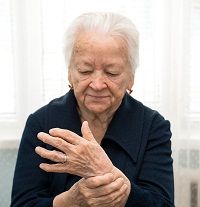Article
Patients with RA and No Inflammation May Experience Neuropathic Pain
Author(s):
Treatment advances in rheumatoid arthritis (RA), including the development and widespread deployment of disease-modifying antirheumatic drugs (DMARDs) and biologic therapies, mean that patients now often have significant periods of low disease activity. But a study in Arthritis Research & Therapy indicates that even patients reaching sustained remission report some potential neuropathic pain even when inflammation is well-controlled.

Treatment advances in rheumatoid arthritis (RA), including the development and widespread deployment of disease-modifying antirheumatic drugs (DMARDs) and biologic therapies, mean that patients now often have significant periods of low disease activity. But a study in Arthritis Research & Therapy indicates that even patients reaching sustained remission report some potential neuropathic pain even when inflammation is well-controlled.
“This suggests that inflammation or subsequent joint damage might not be the only factor causing pain in RA,” the study authors explained. They suggest that neuropathic pain, including hyperalgesia and allodynia, may be present even in the absence of noxious stimuli or peripheral inflammatory pathology. Neuropathic pain may be present in other rheumatic conditions as well, including osteoarthritis, fibromyalgia, and ankylosing spondylitis, suggesting a mixed pain concept in which different pain mechanisms are operating simultaneously. Typical RA therapy does not address neuropathic pain.
Data for this study were collected within the Dutch Rheumatoid Arthritis Monitoring (DREAM) registry, a prospective, multicenter initiative to monitor the course of patients with RA in the Netherlands. The researchers used the painDETECT screening tool to identify possible or likely neuropathic pain in 159 outpatients with RA. painDETECT is a questionnaire often used to distinguish between neuropathic pain and other types of pain. Patients additionally completed other self-reported measures, while clinical measures were assessed to calculate the 28-joint Disease Activity Score. Univariate analyses and multivariable logistic regression were used to identify factors associated with neuropathic pain features.
According to the painDETECT, 27 patients (17%) were classified as having likely neuropathic pain and 34 patients (21.4%) as having possible neuropathic pain. Besides reporting more severe pain, patients with likely or possible neuropathic pain were more likely to meet the diagnostic criteria for fibromyalgia, use analgesics, and have more tender joints, as well as have a worse physical and mental health status as measured by the 36-item Short-Form health survey. In multivariable analysis, physical (P < 0.001) and mental health status (P = 0.006) remained significantly associated with neuropathic pain features, even after controlling for pain severity.
While the proportion of patients with RA and likely neuropathic pain was clearly lower than that usually reported in patients with osteoarthritis and much lower than for fibromyalgia patients, , the findings of the current study provide preliminary support of a noninflammatory pain component in RA that could have important implications for treatment strategies.
“These findings suggest that a sizeable proportion of patients with relatively well-controlled rheumatoid arthritis report symptoms suggestive of neuropathic pain,” the authors concluded.





